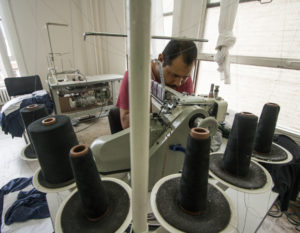A Peek Behind the Curtain
I recently met up  with someone looking to start their own apparel line, and our conversation brought the different classes of outdoor companies into stark contrast. We started talking with a brief history of the Conation Collective. I explained how I sketched out some ideas a couple years ago while working at a bike company and then started talking to manufacturers. There weren’t products on the market that resembled what I envisioned so Conation had to start from scratch. First we sourced fabric and chamois from around the world, but the fabric only came in solid-color rolls so we had to find an artist to create our western look. After digitizing the artist’s work we found most domestic print shops are set up for tee shirt production, but since we wanted to print fabric by the roll we had to locate a printer across the country to do it. Several people deeply involved in the apparel production industry told us there was no way to produce the kind of technical clothing in America at the volume (or lack thereof) that we wanted. They were almost right, but after 3 failed sample runs we finally found a solution to our manufacturing issues. Despite thinking we were in the home stretch we still had to scale fit specifically for cyclist’s body type, source a second print shop after the first one ate a bunch of fabric printing off-colors, and deal with supply chain issues that pushed our production back to September.
with someone looking to start their own apparel line, and our conversation brought the different classes of outdoor companies into stark contrast. We started talking with a brief history of the Conation Collective. I explained how I sketched out some ideas a couple years ago while working at a bike company and then started talking to manufacturers. There weren’t products on the market that resembled what I envisioned so Conation had to start from scratch. First we sourced fabric and chamois from around the world, but the fabric only came in solid-color rolls so we had to find an artist to create our western look. After digitizing the artist’s work we found most domestic print shops are set up for tee shirt production, but since we wanted to print fabric by the roll we had to locate a printer across the country to do it. Several people deeply involved in the apparel production industry told us there was no way to produce the kind of technical clothing in America at the volume (or lack thereof) that we wanted. They were almost right, but after 3 failed sample runs we finally found a solution to our manufacturing issues. Despite thinking we were in the home stretch we still had to scale fit specifically for cyclist’s body type, source a second print shop after the first one ate a bunch of fabric printing off-colors, and deal with supply chain issues that pushed our production back to September.
It was a wild ride, but it allowed us to have complete control over the production of Conation Collective apparel, making sure no corners were cut when it came to the garments we’re proud to put our name on. Conation Collective had to go through all of that because our competitive advantage is product-based, coming from creating garments that aren’t on the market already.
But a lot of companies aren’t like that, and simply recreate existing products with their own take on the branding – essentially a marketing company that is tied to in-house products. Several years ago I worked for a wheel company whose founder hadn’t considered if he was a proponent of the low rotational mass but high aerodynamic penalty of wheels with light rims that necessitate higher spoke counts, or thought aerodynamic benefit outweighed the weight penalty of a stronger rimmed wheel. He said he had simply picked cool looking wheels from a catalog in Asia, pasted some stickers on the rims, and voila, he had a wheel company.
But how do we know this is a pervasive trend? To start, we can look at the labels and fit on supposed “outdoor” apparel. We all know that cotton has terrible performance characteristics yet we find it in apparel because outdoor brands aren’t sourcing their own fabric. Or check out the fit of apparel. Tall people end up with shirts that look like tents because they’re being fit from a generic manufacturing model, not corrected for an athletic body type. And it’s not just our industry, as evidenced by this article about craft whiskey.
If these big factories were creating awesome products that were beneficial to riders, we understand less people would care about small companies making products in America. But we don’t think they’re putting out awesome products, and we don’t think that flashy marketing makes a wheel spin faster or a jersey fit better or whiskey go down smoother. So pick up a piece of Conation Collective apparel today and experience real product differentiation – with quality, fit, and passion.

Leave a Comment